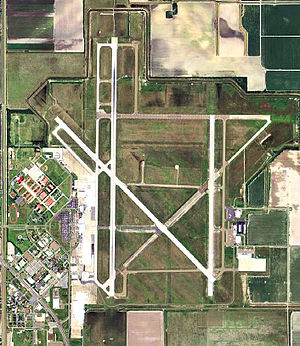Harlingen Air Force Base
| Harlingen Air Force Base Harlingen Army Airfield |
|
|---|---|
| Part of Air Training Command (ATC) | |
| Located near: Harlingen, Texas | |

2006 USGS Airphoto
|
|
| Coordinates | 26°13′43″N 97°39′16″W / 26.22861°N 97.65444°W |
| Site history | |
| Built | 1941 |
| In use | Open 1941 - closed 1962 |
| Garrison information | |
| Garrison | 3610th Navigator Training Wing |
| Airfield information | |||||||||||||||||||
|---|---|---|---|---|---|---|---|---|---|---|---|---|---|---|---|---|---|---|---|
| Summary | |||||||||||||||||||
| Airport type | Public | ||||||||||||||||||
| Elevation AMSL | 36 ft / 11 m | ||||||||||||||||||
| Coordinates | 26°13′43″N 097°39′16″W / 26.22861°N 97.65444°WCoordinates: 26°13′43″N 097°39′16″W / 26.22861°N 97.65444°W | ||||||||||||||||||
| Map | |||||||||||||||||||
| Location of Harlingen Air Force Base | |||||||||||||||||||
| Runways | |||||||||||||||||||
|
|||||||||||||||||||
Harlingen Air Force Base, originally Harlingen Army Airfield, is a former United States Air Force base located in northeast Harlingen, Texas, United States. After its closure, the airport was redeveloped into Valley International Airport.
With the outbreak of World War II in Europe in September 1940, the U.S. Government saw the need to expedite military readiness. It would create a military airfield in Harlingen. The city voted a $105,000 bond issue to acquire 960 acres to be leased to the War Department for 24 years and upon which the field would be constructed. Fifteen farmhouses and buildings on the site were removed, but one building was left in place to become the field office. Col John R. Morgan became the first commanding officer of the Harlingen Aerial Gunnery School arriving in August 1941 to assume that assignment. He was to hold that appointment for the duration of World War II. On June 30, 1941 a contract was let for Morgan and Zachary, El Paso and Laredo builders, to start the military airfield construction. The mission of Harlingen Army Airfield was to train aerial gunners. The school received its first assigned cadre in August 1941. Its primary mission, with an initial student load of 600, was that of training aerial gunnery students in a five-week (extended to six weeks in 1943) training program. Over 48,000 soldiers were trained until the school, one of three such types in the country, closed in 1945. It was initially assigned to the AAF Gulf Coast Training Center as a flexible gunnery school, with the 78th Service Group being designated as the first host organization at the new airfield.
By mid-September 1941 the airfield and base at Harlingen was 30 percent complete. By mid-October the work was half-finished, but the field itself was almost complete. In November the steel water tower which would loom over the base for many years was swung into place. December saw the steelwork on two hangars and control towers well under way.
The airfield consisted of two parallel 6000-foot runways aligned North/South, and two 5,200-foot diagonal runways aligned NE/SW and NW/SE. A large parking ramp and several aircraft hangars were constructed along with a support base of warehouses, dormatories, a fire station, some water towers and a number of support buildings all constructed of wood and tar paper on concrete blocks. An auxiliary airfield at Port Isabel, Texas was also constructed to support the training and flight operations at Harlingen. Training was conducted in both air-to-air & air-to-surface gunnery. The air-to-air training used a variety of aircraft, including AT-6 Texans, BT-13 Valiants, P-63 Kingcobras, B-17 Flying Fortresses and B-24 Liberators. For ground-based training, a number of facilities were available, including the moving target ranges and a number of gunnery simulators. The first class of aerial gunners graduated from the Gunnery School in January 1942.
...
Wikipedia


